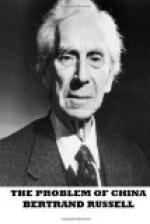In the light of these facts, some other explanation of the relations between the Shogunate and the Imperial Court must be sought than that which depends upon the claim now made by Japanese historians of the official type, that the throne, throughout this whole period, was divinely preserved by the Heavenly Gods.[46]
What happened, in outline, seems to have been a combination of very different forces. There were antiquarians who observed that the Mikado had had real power in the tenth century, and who wished to revert to the ancient customs. There were patriots who were annoyed with the Shogun for yielding to the pressure of the white men and concluding commercial treaties with them. And there were the western clans, which had never willingly submitted to the authority of the Shogun. To quote McLaren once more (p. 33):—
The movement to restore the Emperor was coupled with a form of Chauvinism or intense nationalism which may be summed up in the expression “Exalt the Emperor! Away with the barbarians!” (Kinno! Joi!) From this it would appear that the Dutch scholars’ work in enlightening the nation upon the subject of foreign scientific attainments was anathema, but a conclusion of that kind must not be hastily arrived at. The cry, “Away with the barbarians!” was directed against Perry and the envoys of other foreign Powers, but there was nothing in that slogan which indicates a general unwillingness to emulate the foreigners’ achievements in armaments or military tactics. In fact, for a number of years previous to 1853, Satsuma and Choshu and other western clans had been very busily engaged in manufacturing guns and practising gunnery: to that extent, at any rate, the discoveries of the students of European sciences had been deliberately used by those men who were to be foremost in the Restoration.
This passage gives the key to the spirit which has animated modern Japan down to the present day.
The Restoration was, to a greater extent than is usually realized in the West, a conservative and even reactionary movement. Professor Murdoch, in his authoritative History of Japan,[47] says:—




